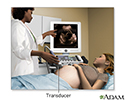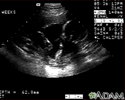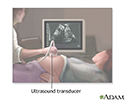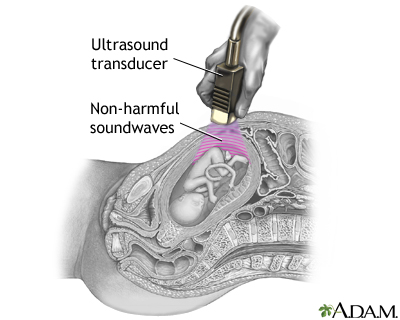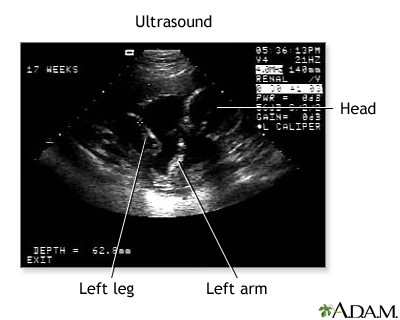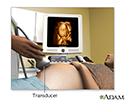Ultrasound pregnancy
Pregnancy sonogram; Obstetric ultrasonography; Obstetric sonogram; Ultrasound - pregnancy; IUGR - ultrasound; Intrauterine growth - ultrasound; Polyhydramnios - ultrasound; Oligohydramnios - ultrasound; Placenta previa - ultrasound; Multiple pregnancy - ultrasound; Vaginal bleeding during pregnancy - ultrasound; Fetal monitoring - ultrasound
A pregnancy ultrasound is an imaging test that uses sound waves to create a picture of how a baby is developing in the womb. It is also used to check the female pelvic organs during pregnancy.
How the Test is Performed
To have the procedure:
- You will lie on your back on an exam table.
- The person performing the test will spread a clear, water-based gel on your belly and pelvis area. A handheld probe will then be moved the area. The gel helps the probe transmit sound waves.
- These waves bounce off the body structures, including the developing baby, to create a picture on the ultrasound machine.
In some cases, a pregnancy ultrasound may be done by placing the probe into the vagina .
Placing the probe into the vagina
Transvaginal ultrasound is a test used to look at a woman's uterus, ovaries, tubes, cervix and pelvic area. Transvaginal means across or through the ...

How to Prepare for the Test
You will need to have a full bladder to get the best ultrasound image. You may be asked to drink 2 to 3 glasses of liquid an hour before the test. DO NOT urinate before the procedure.
How the Test will Feel
There may be some discomfort from pressure on the full bladder. The conducting gel may feel slightly cold and wet. You will not feel the ultrasound waves.
Why the Test is Performed
An ultrasound may be done to determine if there is a problem with the pregnancy, how far along the pregnancy is, or to take measurements and screen for potential problems.
Talk to your health care provider to determine the most appropriate scanning schedule for you.
A pregnancy ultrasound may be done during the first 12 weeks of pregnancy to:
- Confirm a normal pregnancy
- Determine the baby's age
- Look for problems, such as ectopic pregnancies or the chances for a miscarriage
- Determine the baby's heart rate
- Look for multiple pregnancies (such as twins and triplets)
- Identify problems of the placenta, uterus, cervix, and ovaries
-
Look for findings that might indicate an increased risk for
Down syndrome
Down syndrome
The nuchal translucency test measures the nuchal fold thickness. This is an area of tissue at the back of an unborn baby's neck. Measuring this thi...
Read Article Now Book Mark Article
A pregnancy ultrasound may also be done in the second and third trimesters to:
- Determine the baby's age, growth, position, and sometimes gender
- Identify any problems with how the fetus is developing
- Look for twins or triplets. Look at the placenta, amniotic fluid, and pelvis
Some centers are now performing a pregnancy ultrasound around 9 to 13 weeks of pregnancy to look for signs of Down syndrome or other problems in the developing baby. This test is often combined with blood tests to improve the accuracy of results.
How many ultrasounds you will need depends on whether a previous scan or blood test has detected problems that require follow-up testing.
Normal Results
The developing baby, placenta, amniotic fluid, and surrounding structures appear normal for the gestational age.
Note: Normal results may vary slightly. Talk to your doctor about the meaning of your specific test results.
What Abnormal Results Mean
Abnormal ultrasound results may be due to some of the following conditions:
- Birth defects
-
Ectopic pregnancy
Ectopic pregnancy
An ectopic pregnancy is a pregnancy that occurs outside the womb (uterus). It is life-threatening to the mother.
 ImageRead Article Now Book Mark Article
ImageRead Article Now Book Mark Article - Poor growth of a baby while in the mother's womb
- Multiple pregnancies
- Miscarriage
- Problems with the baby's position in the womb
- Problems with the placenta, including placenta previa and placental abruption
- Too little amniotic fluid
-
Too much amniotic fluid (
polyhydramnios
)
Polyhydramnios
Polyhydramnios occurs when too much amniotic fluid builds up during pregnancy. It is also called amniotic fluid disorder, or hydramnios.
 ImageRead Article Now Book Mark Article
ImageRead Article Now Book Mark Article - Tumors of pregnancy, including gestational trophoblastic disease
- Other problems with the ovaries, uterus, and remaining pelvic structures
Risks
Current ultrasound techniques appear to be safe. Ultrasound does not involve radiation.
References
Richards DS. Obstetrical ultrasound: imaging, dating, and growth. In: Gabbe SG, Niebyl JR, Simpson JL, et al, eds. Obstetrics: Normal and Problem Pregnancies . 6th ed. Philadelphia, PA: Elsevier Saunders; 2012:chap 9.
Tayal VS. Emergency ultrasound. In Marx JA, Hockberger RS, Walls RM, eds. Rosen's Emergency Medicine: Concepts and Clinical Practice . 8th ed. Philadelphia, PA: Elsevier Saunders; 2014:chap 196.
Wolf RB. Abdominal imaging. In: Creasy RK, Resnick R, Iams JD, Lockwood CJ, Moore TR, Greene MF, eds. Creasy and Resnik's Maternal-Fetal Medicine: Principles and Practice . 7th ed. Philadelphia, PA: Elsevier Saunders; 2014:chap 24.
-
Ultrasound in pregnancy - illustration
The ultrasound has become a standard procedure used during pregnancy. It can demonstrate fetal growth and can detect increasing numbers of conditions in the fetus including meningomyelocele, congenital heart disease, kidney abnormalities, hydrocephalus, anencephaly, club feet, and other deformities. Ultrasound does not produce ionizing radiation and is considered a very safe procedure for both the mother and the fetus.
Ultrasound in pregnancy
illustration
-
Ultrasound, normal fetus - abdomen measurements - illustration
This is a normal fetal ultrasound performed at 19 weeks gestation. Many health care providers like to have fetal measurements to verify the size of the fetus and to look for any abnormalities. This ultrasound is of an abdominal measurement. It shows a cross-section of the abdomen, and the measurements are indicated by the cross hairs and dotted lines.
Ultrasound, normal fetus - abdomen measurements
illustration
-
Ultrasound, normal fetus - arm and legs - illustration
This is a normal fetal ultrasound performed at 17 weeks gestation. This is the type of image pregnant mothers may see on the ultrasound screen, or that the technician may print. It shows the head on the right, and the cross hair pointing to the left ankle. The left leg and arm are visible in the center of the screen.
Ultrasound, normal fetus - arm and legs
illustration
-
Ultrasound, normal placenta - Braxton Hicks - illustration
This is a normal ultrasound performed at 17 weeks gestation. It shows the placenta during a normal (Braxton Hicks) contraction. Throughout the pregnancy, the uterus periodically contracts to facilitate better blood flow through the placenta and the fetus. In this ultrasound, the placenta can be seen as the mound-shaped object in the middle of the screen. At the bottom of the image, the mother's vertebra can be seen as a round object. When the uterus is not contracting, the placenta would appear much flatter.
Ultrasound, normal placenta - Braxton Hicks
illustration
-
Ultrasound, normal fetus - face - illustration
This is a normal ultrasound of the fetus performed at 17 weeks gestation. The fetal face can be seen in the middle of the screen. The head is tilted left toward the placenta, which can be seen as a mound in the left of the ultrasound image. Both eyes are visible, and the area of white within the eye is the lens. Other facial features, such as the nose and mouth, are also visible.
Ultrasound, normal fetus - face
illustration
-
Ultrasound, normal fetus - femur measurement - illustration
This is a normal ultrasound of the fetus performed at 19 weeks gestation. A clear view of the left femur (the large bone of the leg) can be seen in the middle, towards the top of the ultrasound screen.
Ultrasound, normal fetus - femur measurement
illustration
-
Ultrasound, normal fetus - foot - illustration
This is a normal ultrasound of a fetus at 19 weeks gestation. The right foot, including the developing bones, are clearly visible in the middle of the screen.
Ultrasound, normal fetus - foot
illustration
-
Ultrasound, normal fetus - head measurements - illustration
This is a normal fetal ultrasound performed at 19 weeks gestation. Many health care providers like to have fetal measurements to verify the size of the fetus and to look for any abnormalities. This ultrasound is of a head measurement, indicated by the cross hairs and dotted lines.
Ultrasound, normal fetus - head measurements
illustration
-
Ultrasound, normal fetus - heartbeat - illustration
This is a normal fetal ultrasound showing one pattern of the fetal heartbeat. Some ultrasound machines have the ability to focus on different areas of the heart and evaluate the heartbeat. This is useful in the early diagnosis of congenital heart abnormalities.
Ultrasound, normal fetus - heartbeat
illustration
-
Ultrasound, ventricular septal defect - heartbeat - illustration
This is an ultrasound showing a ventricular septal defect pattern of the fetal heartbeat. Some ultrasound machines have the ability to focus on different areas of the heart and evaluate the heartbeat. This is useful in the early diagnosis of congenital heart abnormalities.
Ultrasound, ventricular septal defect - heartbeat
illustration
-
Ultrasound, normal fetus - arms and legs - illustration
This is a normal fetal ultrasound performed at 19 weeks gestation. This is the type of spilt-screen display you might see during an ultrasound, or if the technician prints a copy of the ultrasound for you. This ultrasound shows both the left arm (seen in the left side of the display), and the lower extremities (seen in the right side of the display). The white areas of the arm or legs is developing bone.
Ultrasound, normal fetus - arms and legs
illustration
-
Ultrasound, normal relaxed placenta - illustration
This is a normal fetal ultrasound performed at 19 weeks gestation. This ultrasound shows two interesting features. In the foreground, to the left and middle of the screen, you can see the placenta, following the curve of the uterus. In the background on the right, where the cross hair is pointing, you can see the face with all the facial features visible.
Ultrasound, normal relaxed placenta
illustration
-
Ultrasound, normal fetus - profile view - illustration
This is a normal fetal ultrasound performed at 17 weeks gestation. In the middle of the screen, the profile of the fetus is visible. The outline of the head can be seen in the left middle of the screen with the face down and the body in the fetal position extending to the lower right of the head. The outline of the spine can be seen on the right middle side of the screen.
Ultrasound, normal fetus - profile view
illustration
-
Ultrasound, normal fetus - spine and ribs - illustration
This is a normal fetal ultrasound performed at 30 weeks gestation. In the middle of the screen, a clear outline of the spine and ribs is visible. The cross hair is between two ribs just above the spine.
Ultrasound, normal fetus - spine and ribs
illustration
-
Ultrasound, color - normal umbilical cord - illustration
This is a normal color Doppler ultrasound of the umbilical cord performed at 30 weeks gestation. The cord is the colored area in the middle of the screen, with the different blood vessels represented by different colors. There are normally three vessels in the cord, two arteries and one vein. The umbilical cord is connected to the placenta, located in the middle left of the image.
Ultrasound, color - normal umbilical cord
illustration
-
Ultrasound, normal fetus - ventricles of brain - illustration
This is a normal fetal ultrasound performed at 17 weeks gestation. The development of the brain and nervous system begins early in fetal development. During an ultrasound, the technician usually looks for the presence of brain ventricles. Ventricles are spaces in the brain that are filled with fluid. In this early ultrasound, the ventricles can be seen as light lines extending through the skull, seen in the upper right side of the image. The cross hair is pointing to the front of the skull, and directly to the right, the lines of the ventricles are visible.
Ultrasound, normal fetus - ventricles of brain
illustration
-
Ultrasound - series
Presentation
-
3D ultrasound - illustration
3D ultrasound provides a three dimensional image of the fetus. Sound waves are sent at different angles by the transducer for the computer to reconstruct the height, width, and depth of the image.
3D ultrasound
illustration
-
Ultrasound in pregnancy - illustration
The ultrasound has become a standard procedure used during pregnancy. It can demonstrate fetal growth and can detect increasing numbers of conditions in the fetus including meningomyelocele, congenital heart disease, kidney abnormalities, hydrocephalus, anencephaly, club feet, and other deformities. Ultrasound does not produce ionizing radiation and is considered a very safe procedure for both the mother and the fetus.
Ultrasound in pregnancy
illustration
-
Ultrasound, normal fetus - abdomen measurements - illustration
This is a normal fetal ultrasound performed at 19 weeks gestation. Many health care providers like to have fetal measurements to verify the size of the fetus and to look for any abnormalities. This ultrasound is of an abdominal measurement. It shows a cross-section of the abdomen, and the measurements are indicated by the cross hairs and dotted lines.
Ultrasound, normal fetus - abdomen measurements
illustration
-
Ultrasound, normal fetus - arm and legs - illustration
This is a normal fetal ultrasound performed at 17 weeks gestation. This is the type of image pregnant mothers may see on the ultrasound screen, or that the technician may print. It shows the head on the right, and the cross hair pointing to the left ankle. The left leg and arm are visible in the center of the screen.
Ultrasound, normal fetus - arm and legs
illustration
-
Ultrasound, normal placenta - Braxton Hicks - illustration
This is a normal ultrasound performed at 17 weeks gestation. It shows the placenta during a normal (Braxton Hicks) contraction. Throughout the pregnancy, the uterus periodically contracts to facilitate better blood flow through the placenta and the fetus. In this ultrasound, the placenta can be seen as the mound-shaped object in the middle of the screen. At the bottom of the image, the mother's vertebra can be seen as a round object. When the uterus is not contracting, the placenta would appear much flatter.
Ultrasound, normal placenta - Braxton Hicks
illustration
-
Ultrasound, normal fetus - face - illustration
This is a normal ultrasound of the fetus performed at 17 weeks gestation. The fetal face can be seen in the middle of the screen. The head is tilted left toward the placenta, which can be seen as a mound in the left of the ultrasound image. Both eyes are visible, and the area of white within the eye is the lens. Other facial features, such as the nose and mouth, are also visible.
Ultrasound, normal fetus - face
illustration
-
Ultrasound, normal fetus - femur measurement - illustration
This is a normal ultrasound of the fetus performed at 19 weeks gestation. A clear view of the left femur (the large bone of the leg) can be seen in the middle, towards the top of the ultrasound screen.
Ultrasound, normal fetus - femur measurement
illustration
-
Ultrasound, normal fetus - foot - illustration
This is a normal ultrasound of a fetus at 19 weeks gestation. The right foot, including the developing bones, are clearly visible in the middle of the screen.
Ultrasound, normal fetus - foot
illustration
-
Ultrasound, normal fetus - head measurements - illustration
This is a normal fetal ultrasound performed at 19 weeks gestation. Many health care providers like to have fetal measurements to verify the size of the fetus and to look for any abnormalities. This ultrasound is of a head measurement, indicated by the cross hairs and dotted lines.
Ultrasound, normal fetus - head measurements
illustration
-
Ultrasound, normal fetus - heartbeat - illustration
This is a normal fetal ultrasound showing one pattern of the fetal heartbeat. Some ultrasound machines have the ability to focus on different areas of the heart and evaluate the heartbeat. This is useful in the early diagnosis of congenital heart abnormalities.
Ultrasound, normal fetus - heartbeat
illustration
-
Ultrasound, ventricular septal defect - heartbeat - illustration
This is an ultrasound showing a ventricular septal defect pattern of the fetal heartbeat. Some ultrasound machines have the ability to focus on different areas of the heart and evaluate the heartbeat. This is useful in the early diagnosis of congenital heart abnormalities.
Ultrasound, ventricular septal defect - heartbeat
illustration
-
Ultrasound, normal fetus - arms and legs - illustration
This is a normal fetal ultrasound performed at 19 weeks gestation. This is the type of spilt-screen display you might see during an ultrasound, or if the technician prints a copy of the ultrasound for you. This ultrasound shows both the left arm (seen in the left side of the display), and the lower extremities (seen in the right side of the display). The white areas of the arm or legs is developing bone.
Ultrasound, normal fetus - arms and legs
illustration
-
Ultrasound, normal relaxed placenta - illustration
This is a normal fetal ultrasound performed at 19 weeks gestation. This ultrasound shows two interesting features. In the foreground, to the left and middle of the screen, you can see the placenta, following the curve of the uterus. In the background on the right, where the cross hair is pointing, you can see the face with all the facial features visible.
Ultrasound, normal relaxed placenta
illustration
-
Ultrasound, normal fetus - profile view - illustration
This is a normal fetal ultrasound performed at 17 weeks gestation. In the middle of the screen, the profile of the fetus is visible. The outline of the head can be seen in the left middle of the screen with the face down and the body in the fetal position extending to the lower right of the head. The outline of the spine can be seen on the right middle side of the screen.
Ultrasound, normal fetus - profile view
illustration
-
Ultrasound, normal fetus - spine and ribs - illustration
This is a normal fetal ultrasound performed at 30 weeks gestation. In the middle of the screen, a clear outline of the spine and ribs is visible. The cross hair is between two ribs just above the spine.
Ultrasound, normal fetus - spine and ribs
illustration
-
Ultrasound, color - normal umbilical cord - illustration
This is a normal color Doppler ultrasound of the umbilical cord performed at 30 weeks gestation. The cord is the colored area in the middle of the screen, with the different blood vessels represented by different colors. There are normally three vessels in the cord, two arteries and one vein. The umbilical cord is connected to the placenta, located in the middle left of the image.
Ultrasound, color - normal umbilical cord
illustration
-
Ultrasound, normal fetus - ventricles of brain - illustration
This is a normal fetal ultrasound performed at 17 weeks gestation. The development of the brain and nervous system begins early in fetal development. During an ultrasound, the technician usually looks for the presence of brain ventricles. Ventricles are spaces in the brain that are filled with fluid. In this early ultrasound, the ventricles can be seen as light lines extending through the skull, seen in the upper right side of the image. The cross hair is pointing to the front of the skull, and directly to the right, the lines of the ventricles are visible.
Ultrasound, normal fetus - ventricles of brain
illustration
-
Ultrasound - series
Presentation
-
3D ultrasound - illustration
3D ultrasound provides a three dimensional image of the fetus. Sound waves are sent at different angles by the transducer for the computer to reconstruct the height, width, and depth of the image.
3D ultrasound
illustration
Review Date: 4/5/2016
Reviewed By: Irina Burd, MD, PhD, Associate Professor of Gynecology and Obstetrics at Johns Hopkins University School of Medicine, Baltimore, MD. Review provided by VeriMed Healthcare Network. Also reviewed by David Zieve, MD, MHA, Isla Ogilvie, PhD, and the A.D.A.M. Editorial team.

